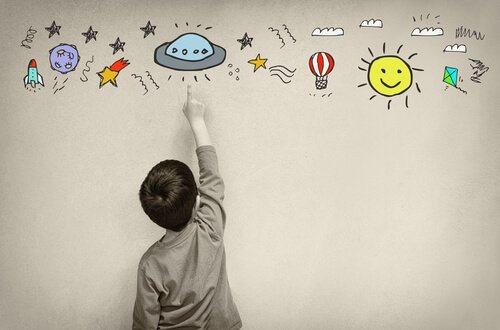7 Tricks to Developing a Resilient Mind in a Child


Written and verified by the psychologist Valeria Sabater
Developing a resilient mind in a child is invaluable. You know that your little ones are capable of extraordinary things. However, the most important thing is for them to be happy. For this to happen, nothing is better than teaching them how to overcome any challenge they may face later on.
These days, you probably hear the term “resilience“ everywhere, from self-help books to conferences about personal growth. However, the idea this concept represents isn’t new, although its effects have been studied in a more rigorous way only recently.
Viktor Frankl already defined his beliefs throughout several books. He did it by teaching how certain people, for example, manage to cope with different challenges thanks to their inner strength, defenses, sense of purpose, and how they deal with adversity.
“What [humanity] really needs is a radical change in attitude towards life.”
-Viktor Frankl-
Therefore, if these skills are so promising, why not instill them in children? Doing so means more than just teaching them techniques to better manage the challenges that they may face. In reality, resilience builds a new mentality inside them. It creates stronger minds, with a greater resistance to stress and with greater executive functions.
Developing a resilient mind in a child is possible if you follow these strategies.
The need to “train” a resilient mind
When you face adversity head-on, your mind experiences stress, or rather, emotional anguish. Thus, this type of response is created and developed in a very specific place: in the brain’s amygdala.
Because this part of the brain is responsible for the brain’s fear-related responses, it’s also the one that sends messages to the brain to release adrenaline and cortisone as soon as possible. It’s as if it’s saying: “React! Move! We have to escape this threat – right now!”
So when the amygdala senses fear, it takes over and something very interesting happens: the prefrontal cortex stops working. That is, the brain’s ability to analyze the situation objectively or reflect on the problem is reduced completely. The body is emotionally kidnapped and dominated by fear without being able to see an escape route.
Therefore, if people were able to teach kids to develop a more resilient mind, these responses wouldn’t happen. At least, they wouldn’t happen as often. Because resilience basically involves calming the amygdala in order to engage the prefrontal cortex. Reducing stress in order to develop a mind that is more open, reflective, and strong. How can we achieve this? Read our tricks below.
1. Strong bonds and healthy attachment: Be the best role model for your child
It’s quite possible that people think that the best way to develop resiliency in children is by teaching them autonomy and independence early on. In reality, the key to developing a resilient mind is an emotional connection.
Kids need healthy, strong attachments. They need the influential people in their lives to offer them unconditional love, security, and protection. All of these things help shape a mind that doesn’t experience fear or stress. A mind that hasn’t had early exposure to the insecurity of fear is a mind that, in the long term, will face life’s problems in a better way. The absence of these experiences creates stronger, flexible, and more receptive minds.
2. Train your executive functions
The goal is to calm the amygdala (fear) and train the prefrontal cortex to carry out executive functions. We have to give them resources to problem-solve, focus their attention, and be creative when facing big or small challenges. The prefrontal cortex helps kids not freeze up when they’re scared.
These are some tricks for developing executive functions in children:
- Establish set routines.
- Model healthy social behaviors.
- Encourage social connections with trusted people.
- Provide opportunities to create their own relationships with their peers (i.e. camps, sports, etc.).
- Play creative games.
- Play memory games.
- Give them opportunities to make their own decisions.

3. Practice mindfulness
Another awesome way of developing a resilient mind in children is mindfulness. Being capable of connecting with the here and now in a relaxed way improves the connections in the brain, helps reduce stress, and improves executive functions. There are many benefits to introducing mindfulness in their lives at an early age.
4. Teach your child that they’re competent and capable
Children must believe they’re competent. They must see themselves as capable of learning from their mistakes and improving. Also, they must believe they can get better at handling new skills to overcome each new challenge. That feeling of love and support from the adults in their lives will allow them to make better decisions over time.
5. Teaching optimism to develop a resilient mind
Realistic optimism can be a great way to help develop resiliency in children. By showing them that real-life problems can be fixed through conscious self-improvement and growth, you show them where their true self-worth resides.

6. Face your fears with support: It’s OK to ask for help!
In order to develop a resilient mind in a child, it’s necessary to help them manage negative emotions, like fear. First of all, you should let them know it’s OK to ask for help, that it’s a great place to start. Also, people who ask for help are brave enough to realize that they’re vulnerable – and those needs give way to deeper, more meaningful relationships.
Helping others and getting help is something children should learn early on. This way, their fears will lose their power until they simply disappear.
7. Learn to build a “problem-solving box”
This idea is as fun as it’s useful! After age 5, a child is capable of learning to solve simple problems on their own.
If the child has a “problem-solving kit” for everyday life, and are shown how to use it properly, it will help them mature. As they grow, each child will learn how to use the tools in their box and adapt them to each challenge they face. Thus, their “problem-solving box” can be filled with some (or all) of these strategies:
Things I can do when I’m worried:
- Talk to mom and dad.
- Ask for help from someone I trust.
- Think about the problem. Is this the first time I’m dealing with it? How did I solve it? Can I do it better now?
- I can solve problems by breaking them down into smaller parts.

The most important thing to remember is that resilient kids have to have been raised with the idea of secure attachment. Their parents should teach them coping strategies and problem-solving skills. This type of learning is active, ongoing, and creative, where the adult models the desired behavior. Therefore, it’s important to remember that raising resilient children is a big responsibility – but it’s an adventure that will always be worthwhile.
Developing a resilient mind in a child is invaluable. You know that your little ones are capable of extraordinary things. However, the most important thing is for them to be happy. For this to happen, nothing is better than teaching them how to overcome any challenge they may face later on.
These days, you probably hear the term “resilience“ everywhere, from self-help books to conferences about personal growth. However, the idea this concept represents isn’t new, although its effects have been studied in a more rigorous way only recently.
Viktor Frankl already defined his beliefs throughout several books. He did it by teaching how certain people, for example, manage to cope with different challenges thanks to their inner strength, defenses, sense of purpose, and how they deal with adversity.
“What [humanity] really needs is a radical change in attitude towards life.”
-Viktor Frankl-
Therefore, if these skills are so promising, why not instill them in children? Doing so means more than just teaching them techniques to better manage the challenges that they may face. In reality, resilience builds a new mentality inside them. It creates stronger minds, with a greater resistance to stress and with greater executive functions.
Developing a resilient mind in a child is possible if you follow these strategies.
The need to “train” a resilient mind
When you face adversity head-on, your mind experiences stress, or rather, emotional anguish. Thus, this type of response is created and developed in a very specific place: in the brain’s amygdala.
Because this part of the brain is responsible for the brain’s fear-related responses, it’s also the one that sends messages to the brain to release adrenaline and cortisone as soon as possible. It’s as if it’s saying: “React! Move! We have to escape this threat – right now!”
So when the amygdala senses fear, it takes over and something very interesting happens: the prefrontal cortex stops working. That is, the brain’s ability to analyze the situation objectively or reflect on the problem is reduced completely. The body is emotionally kidnapped and dominated by fear without being able to see an escape route.
Therefore, if people were able to teach kids to develop a more resilient mind, these responses wouldn’t happen. At least, they wouldn’t happen as often. Because resilience basically involves calming the amygdala in order to engage the prefrontal cortex. Reducing stress in order to develop a mind that is more open, reflective, and strong. How can we achieve this? Read our tricks below.
1. Strong bonds and healthy attachment: Be the best role model for your child
It’s quite possible that people think that the best way to develop resiliency in children is by teaching them autonomy and independence early on. In reality, the key to developing a resilient mind is an emotional connection.
Kids need healthy, strong attachments. They need the influential people in their lives to offer them unconditional love, security, and protection. All of these things help shape a mind that doesn’t experience fear or stress. A mind that hasn’t had early exposure to the insecurity of fear is a mind that, in the long term, will face life’s problems in a better way. The absence of these experiences creates stronger, flexible, and more receptive minds.
2. Train your executive functions
The goal is to calm the amygdala (fear) and train the prefrontal cortex to carry out executive functions. We have to give them resources to problem-solve, focus their attention, and be creative when facing big or small challenges. The prefrontal cortex helps kids not freeze up when they’re scared.
These are some tricks for developing executive functions in children:
- Establish set routines.
- Model healthy social behaviors.
- Encourage social connections with trusted people.
- Provide opportunities to create their own relationships with their peers (i.e. camps, sports, etc.).
- Play creative games.
- Play memory games.
- Give them opportunities to make their own decisions.

3. Practice mindfulness
Another awesome way of developing a resilient mind in children is mindfulness. Being capable of connecting with the here and now in a relaxed way improves the connections in the brain, helps reduce stress, and improves executive functions. There are many benefits to introducing mindfulness in their lives at an early age.
4. Teach your child that they’re competent and capable
Children must believe they’re competent. They must see themselves as capable of learning from their mistakes and improving. Also, they must believe they can get better at handling new skills to overcome each new challenge. That feeling of love and support from the adults in their lives will allow them to make better decisions over time.
5. Teaching optimism to develop a resilient mind
Realistic optimism can be a great way to help develop resiliency in children. By showing them that real-life problems can be fixed through conscious self-improvement and growth, you show them where their true self-worth resides.

6. Face your fears with support: It’s OK to ask for help!
In order to develop a resilient mind in a child, it’s necessary to help them manage negative emotions, like fear. First of all, you should let them know it’s OK to ask for help, that it’s a great place to start. Also, people who ask for help are brave enough to realize that they’re vulnerable – and those needs give way to deeper, more meaningful relationships.
Helping others and getting help is something children should learn early on. This way, their fears will lose their power until they simply disappear.
7. Learn to build a “problem-solving box”
This idea is as fun as it’s useful! After age 5, a child is capable of learning to solve simple problems on their own.
If the child has a “problem-solving kit” for everyday life, and are shown how to use it properly, it will help them mature. As they grow, each child will learn how to use the tools in their box and adapt them to each challenge they face. Thus, their “problem-solving box” can be filled with some (or all) of these strategies:
Things I can do when I’m worried:
- Talk to mom and dad.
- Ask for help from someone I trust.
- Think about the problem. Is this the first time I’m dealing with it? How did I solve it? Can I do it better now?
- I can solve problems by breaking them down into smaller parts.

The most important thing to remember is that resilient kids have to have been raised with the idea of secure attachment. Their parents should teach them coping strategies and problem-solving skills. This type of learning is active, ongoing, and creative, where the adult models the desired behavior. Therefore, it’s important to remember that raising resilient children is a big responsibility – but it’s an adventure that will always be worthwhile.
This text is provided for informational purposes only and does not replace consultation with a professional. If in doubt, consult your specialist.







